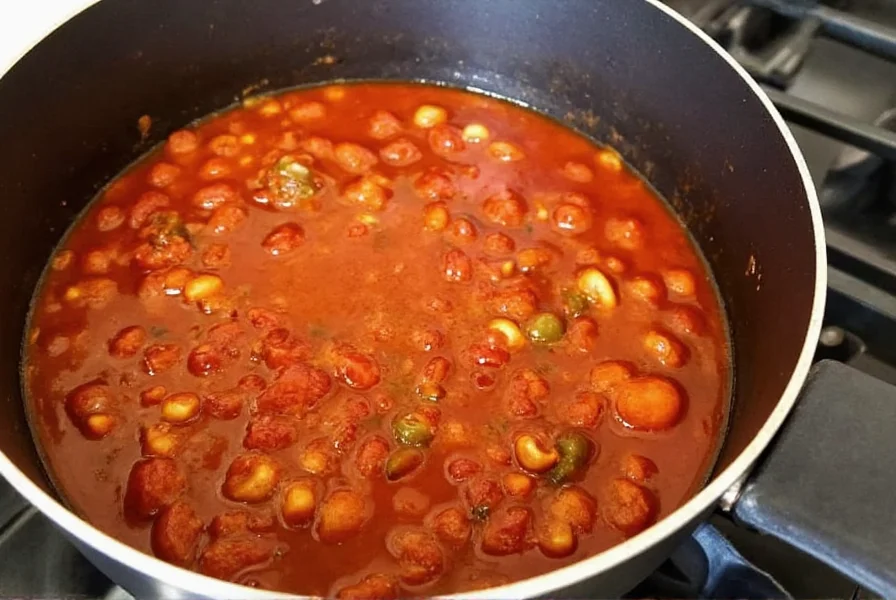If your chili has turned out thinner than desired, don't worry—this common cooking issue has multiple effective solutions. Whether you're mid-cooking or have already finished your batch, these practical methods will transform your watery chili into the hearty, spoon-standing consistency you're aiming for.
Why Your Chili Might Be Too Thin
Understanding why your chili is watery helps prevent future issues. Common causes include:
- Excess liquid from canned tomatoes or beans
- Not cooking long enough to reduce natural moisture
- Adding too much broth or water
- Using high-moisture ingredients like fresh tomatoes
7 Effective Ways to Thicken Chili
1. Simmer Uncovered (The Natural Reduction Method)
This is the simplest and most flavor-preserving technique for how to thicken chili without changing flavor. Remove the lid and let your chili simmer gently for 20-30 minutes. The gentle evaporation concentrates both texture and flavor. Stir occasionally to prevent sticking.

For best results when learning how to fix watery chili after cooking, maintain a low simmer rather than a rapid boil, which can cause ingredients to break down too much.
2. Cornstarch Slurry (Quick Fix Method)
When you need the best way to thicken chili quickly, a cornstarch slurry works in minutes. Mix 1 tablespoon cornstarch with 1 tablespoon cold water per cup of chili until smooth. Gradually whisk into simmering chili and cook for 2-3 minutes until thickened.
| Chili Volume | Cornstarch | Cold Water |
|---|---|---|
| 2 cups | 2 tbsp | 2 tbsp |
| 4 cups | 4 tbsp | 4 tbsp |
| 6 cups | 6 tbsp | 6 tbsp |
Never add dry cornstarch directly to hot chili—it will clump. The thickening chili with cornstarch ratio above ensures perfect consistency without altering taste.
3. Flour-Based Thickening
Create a roux by cooking 2 tablespoons flour with 2 tablespoons fat (like bacon grease from your chili) for 2 minutes until golden. Gradually whisk in ½ cup of your chili broth, then return to the main pot. This method works well for natural ways to thicken chili using pantry staples.
4. Bean Mash Technique
Remove 1-2 cups of chili (primarily beans and solids), mash thoroughly, then return to the pot. This leverages ingredients already in your chili for thickening without introducing new elements—ideal for thickening chili without flour while enhancing texture.
5. Tomato Paste Boost
Stir in 2-3 tablespoons of tomato paste, which contains less water than regular canned tomatoes. Cook for 5 minutes to eliminate any raw flavor. This method simultaneously thickens and deepens your chili's flavor profile.
6. Masa Harina Magic
Mix 2 tablespoons masa harina (corn flour) with ¼ cup cold water, then stir into simmering chili. Cook for 3-5 minutes. This traditional thickener adds a subtle corn flavor that complements most chili recipes beautifully.
7. Additional Solid Ingredients
Incorporate extra beans, diced potatoes, or cooked grains like quinoa. These absorb liquid while adding nutritional value. For bean-based chili, try adding an extra can of drained and rinsed beans.
What NOT to Do When Thickening Chili
- Don't add cold thickeners directly—always make a slurry first
- Avoid over-thickening—remember chili continues thickening as it cools
- Don't boil vigorously after adding starches—this breaks down the thickening molecules
- Never use gelatin—it creates an unpleasant texture in savory dishes
Preventing Thin Chili in Future Batches
For consistently perfect chili thickness:
- Start with less liquid than recipes suggest—you can always add more
- Use tomato paste instead of crushed tomatoes for richer base
- Drain canned beans thoroughly before adding
- Cook uncovered for the final 30 minutes of preparation
- Let chili rest for 15-20 minutes after cooking—this allows further thickening
Troubleshooting Common Issues
Problem: Chili thickened too much
Solution: Gradually add small amounts of broth, beer, or water until desired consistency
Problem: Cornstarch created lumps
Solution: Strain through a fine mesh sieve while chili is still warm
Problem: Thickener altered flavor negatively
Solution: Balance with additional spices, a splash of vinegar, or a pinch of sugar

Final Tips for Perfect Chili Consistency
The ideal chili should coat the back of a spoon but still flow slowly. Remember that chili thickens considerably as it cools, so aim for slightly thinner consistency than desired when serving immediately. For meal prep, make it slightly thinner than perfect since it will thicken in storage. When entertaining, prepare your chili slightly thicker than ideal and thin with broth just before serving to achieve restaurant-perfect consistency every time.











 浙公网安备
33010002000092号
浙公网安备
33010002000092号 浙B2-20120091-4
浙B2-20120091-4